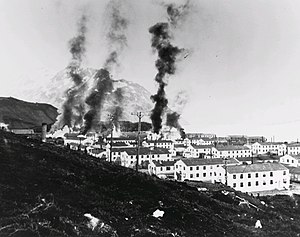Battle of Dutch Harbor
| Battle of Dutch Harbor | |||||||
|---|---|---|---|---|---|---|---|
| Part of the American Theater and the Pacific Theater of World War II | |||||||
 Buildings burning after the first Japanese air attack on Dutch Harbor, 3 June 1942. |
|||||||
|
|||||||
| Belligerents | |||||||
|
|
|
||||||
| Commanders and leaders | |||||||
|
Robert Alfred Theobald Simon Bolivar Buckner, Jr. Archibald V. Arnold |
Kakuji Kakuta | ||||||
| Strength | |||||||
|
37th Infantry Regiment 206th Coast Artillery (AA) 1 search light battery 6 anti-aircraft batteries marines 30 fighters |
2 aircraft carriers 3 cruisers 5 destroyers 40 fighters 21 torpedo bombers 21 dive bombers 4 reconnaissance aircraft |
||||||
| Casualties and losses | |||||||
| 78 dead unknown wounded 3 captured 14 aircraft destroyed Fort Mears moderately damaged Dutch Harbor moderately damaged 1 barracks ship destroyed |
10 dead unknown wounded 5 captured 7 aircraft destroyed |
||||||
The Battle of Dutch Harbor took place on 3–4 June 1942, when the Imperial Japanese Navy launched two aircraft carrier raids on the Dutch Harbor Naval Operating Base and U.S. Army Fort Mears at Dutch Harbor on Amaknak Island, during the Aleutian Islands Campaign of World War II.
In this battle, a Japanese aircraft carrier strike force under Kakuji Kakuta launched air attacks over two days against the Dutch Harbor Naval Base and Fort Mears in Dutch Harbor, Alaska. The attacks inflicted moderate damage on the U.S. base. Shortly thereafter, Japanese naval forces under Boshiro Hosogaya invaded and occupied Attu and Kiska islands in the Aleutians.
On 3 June, a Japanese carrier strike force, under the command of Rear Admiral Kakuji Kakuta, comprising the carriers Ryūjō and Jun'yō, plus escort ships, sailed to 180 mi (160 nmi; 290 km) southwest of Dutch Harbor to launch air strikes at the United States Army and United States Navy facility to support a Japanese offensive in the Aleutians and in the central Pacific at Midway. The Japanese planned to occupy islands in the Aleutians in order to extend their defensive perimeter in the North Pacific to make it more difficult for the U.S. to attack Japan from that area.
...
Wikipedia
